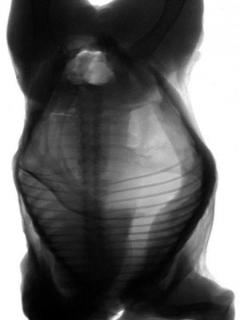Dual Energy X-ray analysis of carcass fatness is similar for different sexes and sire types
A review of the analysis to detect any bias in the data obtained from a Dual Energy X-ray Absorptiometry (DEXA) system when determining carcass composition at chain speed.
Steve Connaughton, Andrew Williams, Fiona Anderson, Sean Starling and Graham Gardner, Murdoch University WA
Corresponding author: S.Connaughton@murdoch.edu.au
Background
The accurate determination of body composition at slaughter is important to enable the lamb industry to efficiently use carcasses in the boning room and to provide accurate feedback for producers for high quality lamb.
Currently the fat component of lamb carcass composition is estimated commercially via palpation of the GR site – a point 110mm along the 12th rib when measured from the spine – to give what is known as a fat score (1-5). Direct measurements of this site can also occur, using rulers, probes, or ultrasound; however these forms of measurement are less common in processing plants.
The GR palpation technique is comparatively imprecise, being entirely subjective to the individual who is conducting the palpation. In fact, operators only palpated the correct rib around 30% of the time in a recent review of Australian abattoirs. This highlights the need for a new method of determining body composition in lambs.
Recent work has identified a specialized form of x-ray technology called DEXA as a possible method for determining body composition in lambs. DEXA technology has the advantage of being objective, reliable and consistent. DEXA utilizes x-rays of differing energies to determine the proportions of fat and lean muscle across the entire carcass; and can achieve these measurements at chain speed in the abattoir. Multiple tests have revealed consistently high correlations between body condition estimates from the DEXA and Computed Tomography (CT), which is considered to be the gold standard.
While DEXA produced good estimates of body composition, in this report we have further examined DEXA data to quantify any measurement biases that may exist between different sexes or sire types.
Materials and methods
To determine the accuracy of the DEXA measurements, the fat percentage of 468 carcasses were calculated by both the DEXA and by computed tomography (CT). The difference between the DEXA fat percentage and the CT fat percentage was calculated for each lamb, and is called the residual.
The residuals help determine the accuracy of the DEXA system; regardless of the sex of each lamb, or the sire breed. Figure 1 shows the relationship between DEXA and CT fat % readings. The residual is the distance of the marker from the black line.
Points to note
- Fat % predicted by DEXA is very similar to the fat % recorded by the computed tomography
- There is a wide range of fat % across the different carcasses
Results and take home messages
Of the 468 carcasses assessed, 217 were female and 251 were male. The percentage of fat was under predicted for female carcasses by 0.4% and over predicted for male carcasses by 0.1%. When the average residual of the male and female lambs is compared (Figure 2), there is only a very small sex bias, with the average of both the male and female residuals below 0.5%. This figure is remarkably small, particularly given the large range in carcass fatness used in the study.
Points to note
- There was a small bias in the estimation of fat % by the DEXA between the sexes
- The bias was very small, less than 0.5%
The breed of the sire of the lamb was also investigated, with a total of 9 sire breeds examined within the dataset. There was slightly greater variation in the average residuals between the sire breeds, than for the sexes. The percentage of fat was under predicted by about 0.7% for the merino sire types (merino and poll merino) and over predicted by about 0.7%, and the terminal sire types (Poll dorset, Texel, Suffolk and White Suffolk) were under predicted by about 0.5% (1% for Texel). However, as with the sexes, the difference was still very small and the average residuals for the DEXA fat compared with the CT fat were 1.1% or less (Figure 3).
Points to note
- There was a small bias in the estimation of fat % by the DEXA between the sire breeds
- The bias was consistent for merino sire breeds and terminal sire breeds but varied for maternals
- The bias was very small, less than 1.1%
Conclusion
These results demonstrate that the DEXA system of predicting carcass fat is both precise and robust, maintaining accuracy over a variety of phenotypic variables including sex, and sire breed. These results give the supply chain significant confidence in the carcass information that can be generated from this DEXA system. This robust information can then be used to optimize multiple points of production – including the selection of flock genetics, farm management, carcass market determination, boning room efficiency and carcass consistency.
Currently, other variables are also being investigated in a similar fashion, to ensure continued confidence in DEXA technology. In addition, further experiments are also being conducted to take advantage of new innovations in the software and hardware in order to guarantee the most accurate information possible.
Acknowledgements
Contributors to this project include MLA, Sheep CRC, JBS, AMPC, Scott’s Automation and Robotics, and Murdoch University.

